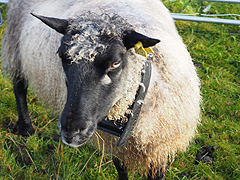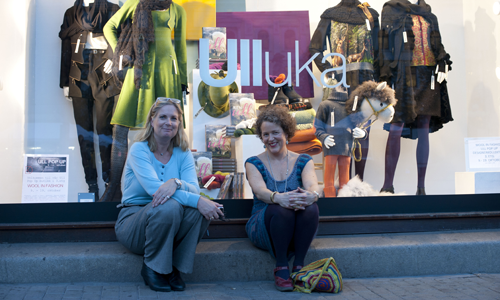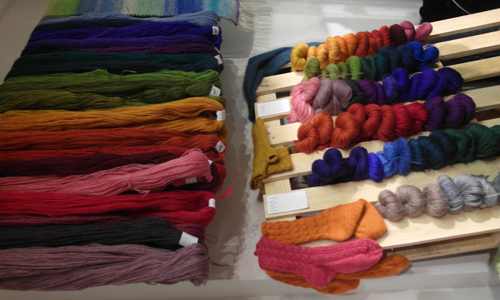Valuable, eco-friendly Norwegian wool

Wool production in Norway has been documented to be more environmentally sound than in other countries. From Norwegian wool, a wide variety of pure, safe materials can be made for use in clothing, textiles, blankets, rugs and insulation. Wool's potential for value creation is promising.
"There are opportunities with wool that we mustn't pass up," says Ingun Grimstad Klepp, Head of Research at Norway's National Institute for Consumer Research (SIFO).
Despite the increasing sales of bunader (traditional folk costumes), wool underwear and knitwear in Norway, less than 25 per cent of the wool used in Norwegian-made textile and yarn products is actually Norwegian. The SIFO project Valuing Norwegian wool has been working to change that.
From sheep to chic
Dr Klepp headed the project, which was launched in 2010 with funding under the Research Council of Norway's Research Programme on Nature-based Industry (NATUROGNAERING), whose activities are now being continued under the Research Programme on Sustainable Innovation in Food and Bio-based Industries (BIONAER). The project was designed to generate new knowledge about how the use of Norwegian wool can make textile production and consumption more environmentally sustainable, while also enhancing value creation based on Norwegian wool in agriculture, commerce and design.
Project researchers have identified the environmental benefits of using Norwegian wool and have helped to develop ideas into new products. The researchers have also worked on concepts for marketing and communication and on spreading innovative ideas and knowledge about Norwegian wool.
One by-product of the research project is the book Ren ull ("Pure Wool"), written by Dr Klepp and journalist Tone Skårdal Tobiasson. The latter has been responsible for dissemination and outreach activities and international cooperation under the project.
Sustainable consumption of clothes
The positive environmental aspect of Norwegian wool has been a recurring theme throughout the project and has been examined from a variety of angles.

"We have documented the practicality of wool when it comes to care," continues Dr Klepp, "and we've generated knowledge that makes it easier for consumers to take advantage of wool's qualities. For instance, it is not necessary to wash woollen garments as often as other materials, because the odour of sweat disappears simply by airing them out."
The researchers have also focused on how the extended lifespan of woollen items promotes more sustainable consumption of clothing. "Knitted jumpers, bunader and peacoats are examples of woollen garments that can retain their shape and beauty and be handed down for generations," Dr Klepp points out.
Fruitful interdisciplinary approach
Several partners have collaborated actively on the project. According to Siri Anzjøn, Special Adviser for the BIONAER programme, the "wool project" was ahead of its time with its interdisciplinary approach and emphasis on dissemination.
"New opportunities arise when we view the different scientific fields and the value chain as an integrated whole – from farm to fashion," adds Dr Klepp. "We have found that research conducted in this manner leads to clearly better results. Good cooperation involves combining experience and knowledge from a variety of backgrounds. This project has really inspired us to do more research of this kind."
Environmental footprint
Designer Kjersti Kviseth at the company 2025design has produced valuable reports on lifecycle analysis and certification schemes for the environmental footprint of various materials.
The reports conclude that Norwegian actors will be able to document the environmental friendliness of Norwegian wool products with the international Cradle to CradleCM certification (see fact box). The certification scheme takes a product's entire lifecycle into consideration, not only the production of its constituent materials.

Together with the industry partners in the project, Ms Kviseth has worked through the process of obtaining the Cradle to Cradle CM environmental approval of Norwegian wool.
So far, one Norwegian raw material for woollen yarn has been approved. The next step is an agreement on using this wool in the world's most environment-friendly carpets for an international airline. "This is quite a breakthrough for Norwegian wool," notes Ms Tobiasson.
Viking gold – a synthesis of design and archaeology
On the heels of the wool project, a new project at the Norwegian Fashion Institute (NFI) is starting up to create high-quality designer products in wool, inspired by Viking textiles. Entitled VikingGull ("Viking gold") and headed by the NFI's Gisle Mariani Mardal, the project is funded under the Nordic Council of Ministers' KreaNord initiative to improve growth prospects for the Nordic region's cultural and creative industries.
The project management group consists of Dr Klepp, Ms Tobiasson and Marianne Vedeler of the University of Oslo's Museum of Cultural History.
"With the VikingGull project," says Ms Tobiasson, "we are drawing attention to Norway's ancient history of textiles and developing a stronger sense of national pride in it, while demonstrating the commercial opportunities through collaboration with archaeological researchers and modern designers."
"We also want to reintroduce the term 'Viking' as a valuable stamp of quality for good textile products," adds Dr Klepp. "Despite the myths, the Vikings didn't wear unaesthetic, matted sacks for clothing, but rather technologically advanced, beautiful, functional textiles."
Provided by The Research Council of Norway














